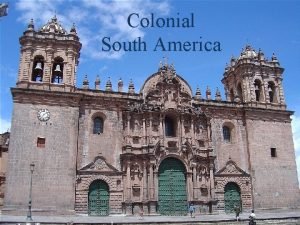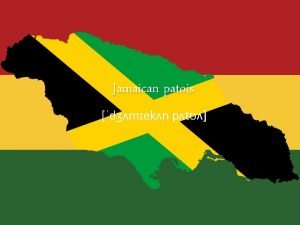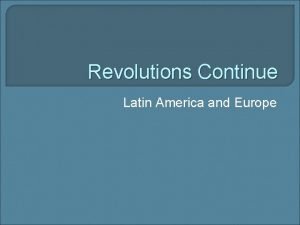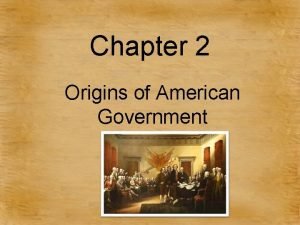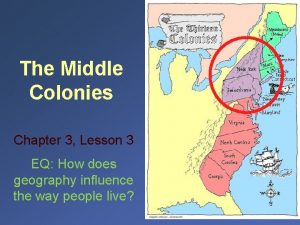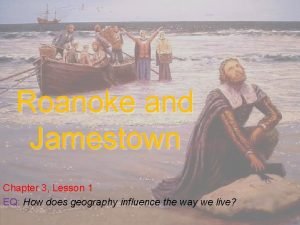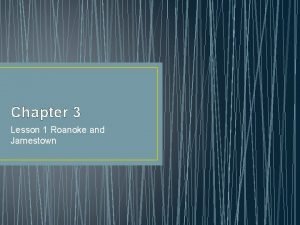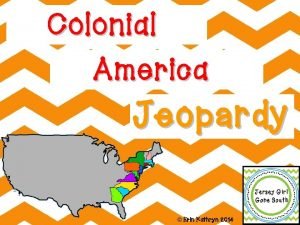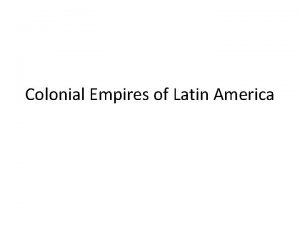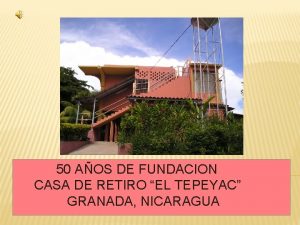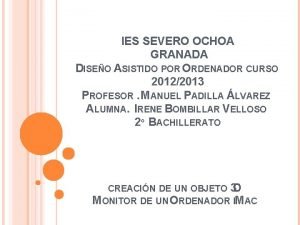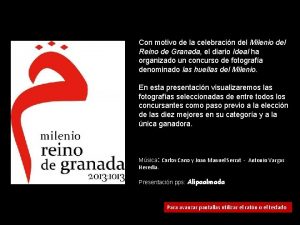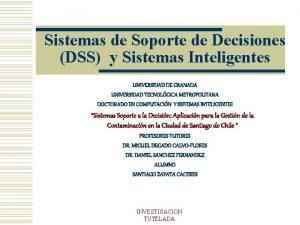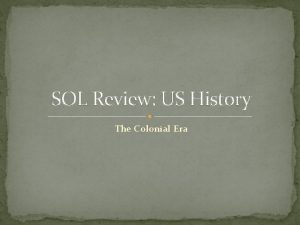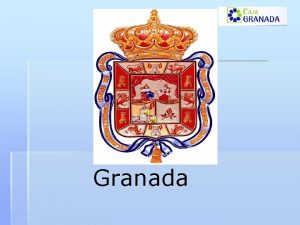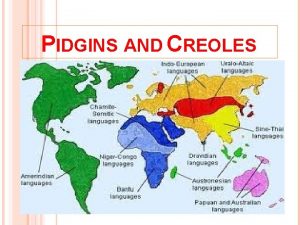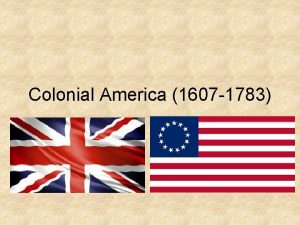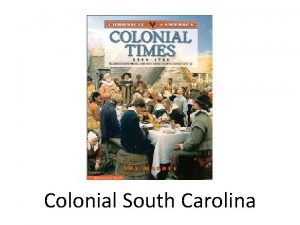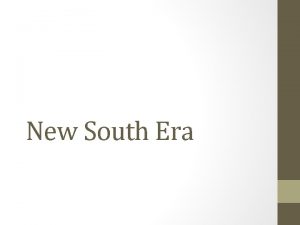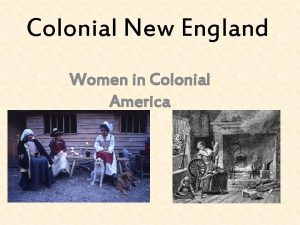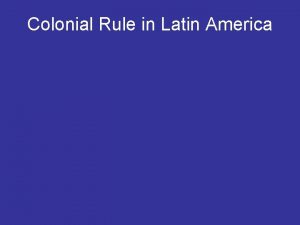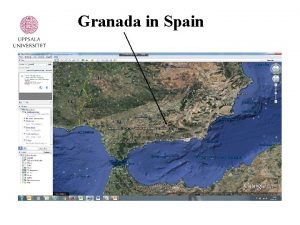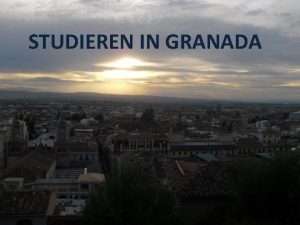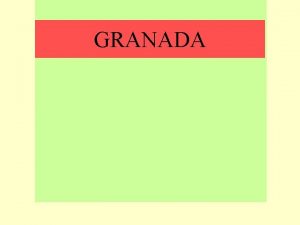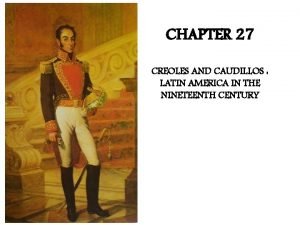Colonial South America New Granada Had fewer creoles































- Slides: 31

Colonial South America


New Granada. . .

• Had fewer creoles than Mexico. – Several revolts in the eighteenth century against the high taxes. – Creoles cooperated with pardos (free black or mulatto craftsmen). – Both supported Fernando VII, deposed by Napoleon. – Formed juntas, or commissions, which removed peninsulares from office.

• Creoles and pardos did not always trust one another. • Both had powerful militias. • Full voting rights were extended to both groups as a compromise. • When Fernando was restored to the throne, he tried to reassert Spanish authority in New Granada.

• Final independence achieved by Simón Bolivar, a wealthy creole. • Bolivar was familiar with European enlightenment principles such as popular sovereignty.

Computer recreation of the likeness of Simon Bolivar (1783 – 1830)

• In 1821, with help from Haiti, Bolivar able to defeat the Spanish and proclaim independent Gran Columbia. • Composed of modern-day Colombia, Venezuela, Ecuador, and Panama. • Bolivar sent troops to help José de San Martin liberate Peru in 1826.


• Bolivar and San Martin disagreed on the future of independent South America. • Bolivar favored a republic with oligarchic rule by creoles. • San Martin favored a Latin American monarchy to stabilize the disparate ethnic, racial, and economic groups. • Bolivar unable to keep Gran Colombia united or to sign a unified constitution. • As late as 1902 the region continued to fracture, as Panama broke free from Columbia.

• Venezuela plagued by political instability, going through caudillo after caudillo. • Foreign economic investment misused by leaders. • As in most of the region there was a struggle between federalism and centralism. • 1811 – Present: – 70 presidents. More than half military officers.

• Independence movements in the viceroyalty of La Plata, which include Argentina, also led by creoles. • Argentina had fewer Amerindians, African slaves, or mixed race peoples. • Two classes of creoles: – portenos of Buenos Aires – creoles of the pampas.


• Upper Peru, with the Potosí silver mines, heavily defended by colonial troops. • Independence movement at a standstill until 1816.


• San Martin created the Army of the Andes, including mulattos and blacks. • Liberated Chile by 1817, before joining with Bolivar. • Tried but failed to introduce social reforms in independent Argentina. • Independence in Argentina was followed by territorial and internal disputes.

Jose de San Martin 1778 - 1850

• War of the Pacific, 1879– 1884, led to Chile annexing Peruvian lands. • Creoles around Buenos Aires wanted strong central government and control over provinces. • The gauchos, creoles in the provinces, wanted loose federal system. • Juan Manuel de Rosas rose from governor of Buenos Aires to caudillo in 1835. – Autocratic rule limited power of the provinces, and led to his overthrow in 1851.

• Justo José de Urquisa replaced de Rosas as president but failed to break the hold of the elite creoles. • Defeated by Buenos Aires forces in 1861. • Pampas increasingly settled as ranch land after 1861, helped by railroads. • Gauchos lost independence and land, and became hired hands. • Power of elites finally broken in 1890 s by Radical Party and Socialists. – Electoral reforms introduced universal male suffrage and secret ballots.

• Argentina – 70 heads of state since 1811 – 33+ military officers

Brazil • Portuguese royal family arrived in Brazil in advance of Napoleon’s conquest in 1807. • Brazil became a coequal kingdom with Portugal, but run independently. • Royal family returned to Portugal in 1822, but Prince Pedro I stayed in Brazil. – Ruled as authoritarian king by divine right. – Tension between plantations: sugar and cotton in the north and coffee in the south. • Plantation creoles wanted more control of law courts, limited immigration, and continued slavery. • Pedro I abdicated in 1831, leaving child Pedro II behind with a regent.

• Provinces given legislative assemblies with tax and budget powers in 1834. • Agitation for an abolition of slavery in the south led to reduced provincial powers in 1840. • Britain, determined to end the slave trade worldwide, sent warships in 1849 to end importation of slaves to Brazil. • Plantations faced labor shortage and blamed monarchy. • Slavery not ended until 1888, the last country in the Western Hemisphere to do so. • Ex-slaves continued to be economically exploited by coffee boom.

• Monarchy dissolved in 1889 by military forces influenced by positivism. • Followed by tensions between. . . – southern coffee plantations who wanted weak central government – urban elites who wanted a strong presidency. • Led to the rise of provincial caudillos. • Agricultural products such as coffee were exchanged for imported manufactured goods.


• Uruguay: 1811 – annexed by Brazil in 1821, independent in 1828 • • Paraguay: 1811 Argentina: 1816, José de San Martín Chile: 1818, Bernardo O’Higgins and San Martin Colombia: 1821, Simon Bolivar: – Venezuela: 1829 – Ecuador: 1830 • Peru: 1821, Simon Bolivar • Brazil: 1822 • Bolivia: 1825

Latin American Society and Economy in the Nineteenth Century • Spanish and Portuguese American colonies were founded on mercantilism. • Manufactured goods provided by Iberia in exchange for colonial raw materials. • Great Britain benefitted most from ending mercantilist limitations in Latin America, as new states turned to Britain for trade. • Provokes the US to issue the “Monroe Doctrine” in 1824.

• Creoles in new Latin American states were divided into two groups: – The elite minority that controlled land, – The majority who were craftsmen and laborers. – Divided most over the issue of voting rights, although both liberals and conservatives wanted to limit voting to men. • Landed conservatives wanted limited voting rights. • Urban constitutional liberals wanted expanded voting rights. • Pattern of constitutionalism set after independence, even under caudillos.

• Roman Catholicism remained the national church for most independent states. • Rome did not recognize independent states until mid-1830 s. • Church was one of the largest landowners in Latin America. • Liberals promoted separation of church and state, by mid-nineteenth century.

• Taxation on trade was one of the most used sources of revenue for Latin America. • Only Mexico developed factories in the nineteenth century. • Most of Latin America developed an exportled economy • Each nation relied on few natural resources or agricultural products for export.

• Nations vulnerable to price fluctuations and world demand. • Relied on inexpensive labor, provided by slavery or by immigration. • As most of the nations relied on a rural labor force, literacy rates stayed low. • Rural areas developed after 1870 s, with the expansion of the railroads.

• Secularization of marriage emphasized property and the power of men. – In the colonial period, marriage governed by Catholic Church, which emphasized gender equality in marriage. • Culturally, women’s roles as homemakers emphasized, even if economically they had more diverse roles. • Early widowhood common, which allowed women a choice to remarry or not. • Latin American arts remained heavily influenced by European trends. – Movement toward indigenization, to break away from European influences.
 Granada south america
Granada south america Fewer bills, fewer problems
Fewer bills, fewer problems Pidgin language
Pidgin language Creoles
Creoles Nautical jargon theory
Nautical jargon theory Peninsulares
Peninsulares Europe vs asia
Europe vs asia Old south vs new south streetcar named desire
Old south vs new south streetcar named desire Colonial america sports
Colonial america sports Chapter 2 lesson 1 government in colonial america answers
Chapter 2 lesson 1 government in colonial america answers Guided reading lesson 3 the middle colonies
Guided reading lesson 3 the middle colonies Lesson 1 roanoke and jamestown
Lesson 1 roanoke and jamestown Colonial america lesson 1 roanoke and jamestown
Colonial america lesson 1 roanoke and jamestown Colonial america sports
Colonial america sports Colonial america jeopardy
Colonial america jeopardy Colonial america jeopardy
Colonial america jeopardy Colonial empires in latin america
Colonial empires in latin america Casa de retiro tepeyac granada
Casa de retiro tepeyac granada Uait
Uait Best life experience granada
Best life experience granada Ipep granada horarios
Ipep granada horarios Orbita
Orbita Iespm granada
Iespm granada Capilla real granada
Capilla real granada Nota de corte ade granada
Nota de corte ade granada Realizado
Realizado En la calma oliente y negra suena un agrio cornetín
En la calma oliente y negra suena un agrio cornetín Cooperativa de energia granada
Cooperativa de energia granada Granada
Granada Erasmus granada
Erasmus granada In the colonial era developments such as the new england
In the colonial era developments such as the new england I had my breakfast
I had my breakfast
